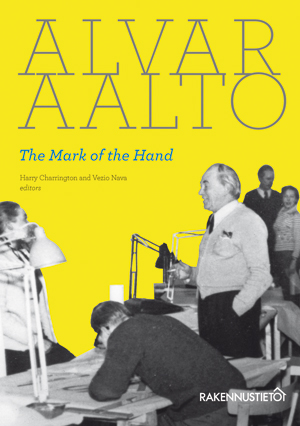Thirty-five years after Alvar Aalto's death, his reputation as one of the giants of modern architecture remains unassailable. While the Euro has replaced the 50 Finnmark notes that carried Aalto's image into every Finn's daily life, his shadow looms large over Finland. For example, the University of Art and Design Helsinki merged in 2010 with the Helsinki School of Economics and Helsinki University of Technology to form a new institution named The Aalto University. As with any iconic figure, there is a constant process of re-evaluation and burnishing the myth.

For Aalto, as for Wright and Le Corbusier, there seems to be an endless stream of new writings. Since we know little about how Aalto actually worked, The Mark of the Hand is one of the more worthwhile books on the architect—a messy history that deals with the personalities and atmosphere of his office. Edited by an Englishman and an Italian, both of whom worked for the maestro, the book distills the essence of interviews with 28 architects who shaped the Aalto atelier for half a century. More than lectures or writings could, these voices offer remarkable insight into the workings of the office, and of the man himself.
We learn that Aalto eschewed rulers and always used a 6B pencil. He loved and relied on models, even paying for them out of pocket if necessary. Aalto purposely kept his studio small, employed only architects, and allowed no job titles. He trusted his workers, expecting them to make their own judgments—and mistakes. "The great thing about this office was that it allowed everyone to do their best." But he was suspicious of teamwork and oversaw every detail before it left the office. Unusual for the time, he gave full responsibility to women, and although the "pay here was always rotten," he was ever ready to extend interest-free loans.
Aalto roamed the atelier speaking several languages and welcomed the steady stream of foreigners who came through, such as Louis Kahn, Richard Neutra, and Lucio Costa. He was well traveled, well connected, and well dressed. ("A gentleman will not reveal the name of his tailor or his lover.") But he was also petty and could be obnoxious (his alcohol consumption was legendary). When the President of Finland invited him to share a sauna, Aalto declined, saying, "I have creative work to do." His secretary recalls never having seen her boss so jolly as when it was announced that Corbu had died. ("Aalto said that now he is best architect in the world.")
While it is not surprising to learn that Aalto was, as Charrington remembers, "kind, cunning, caring, and cruel," this book provides a lot of personal information that helps us better understand how works such as Finlandia Hall, the civic buildings in Seinäjoki, the Pensions Institute, and many other great buildings were conceived, drawn, and ushered into being. The Mark of the Hand is crammed with enough details and revealed facets to keep Alvaristi enthralled for all 400-plus pages.
A typical story is Veli Paatela's recollection of building Baker House at MIT: "As soon as it was announced that the dormitory would be brick, brick agents started crowding the office with suitcases full of shiny, perfect bricks. Machine-cut, oil-fired bricks. Perfection is big in America." Then Paatela found a small brick maker, whose workers "walked barefoot on the clay from which the bricks were fired. They only extracted one layer of clay every year and then let the sun burn the surface again." Needless to say, these sun-dried, wood-fired bricks cost a lot more, but the ever-persuasive Aalto convinced the building committee to go with the robust masonry. Every time I pass Baker House, I am especially grateful.




Post a comment to this article
Report Abusive Comment